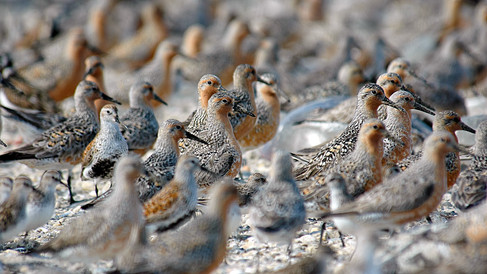Explore the Top 5 Birding Wonders of the US: A Birdwatcher's Dream
- Zach (Head Flocker)
- Feb 12
- 7 min read
Typically, when a list is created to catalog the Wonders of the World, seven sites are included. However, this list is only for the US, and since the US uses the standard system, the conversion leaves us with the Top five birding wonders of the US!
(See? If we switched to the metric system, this would be a list of seven.)

I could add plenty of additional wonders to this list, everything from impressive flocks of wintering corvids to mass movements of warblers along the Great Lakes or Atlantic Coast. There are even locations with gatherings of hundreds to thousands of loons that make for quite the chorus! But none of these rank on THIS list. In fact, leaving off the impressive displays put on by game birds should instigate a mob with torches and pitchforks. I can only do so much in a single post!
NOW…
On to number 5!.... But first, the OLI, aka the outside looking in.
You will notice a theme with the two OLIs. They are wonders I have yet to experience. However, they are on this list because of their reputation... and my desire to be enveloped fully in their wonder.
First OLI: Wintering owls and finches in Sax Zim Bog
Great Gray Owls are one of the most sought-after species in North America. And while they may never appear in the thousands together, the Sax Zim Bog, in winter, can provide some incredible viewing experiences that might prove otherwise quite tricky. In addition to the Great Gray Owl, it is possible to see NINE more owl species in the bog in winter. In addition to the owls, a full finch fellowship assembles during peak visiting season. Evening and Pine Grosbeaks, Redpolls, Purple Finches, and crossbills are all icing on a snowy, bog-filled cake. And while finch flights are impressive, a double-digit owl locale is what truly makes the Sax Zim Bog a Birding Wonder of the US.
Second OLI: Red Knot migration in Delaware Bay
While this wonder is one that is on my MUST BIRD list, I cannot exclude it simply because I have no experience with it. Instead, I encourage you to join me in a future adventure to see this dimming light of shorebird migration. Why dimming? At one time in history, well over 100,000 Red Knots likely migrated and stopped on Delaware Bay during spring migration. Now, less than 15,000 remain. While this beacon of Red Knot is not quite so bright, it still boasts over ten thousand Red Knots, plus countless other shorebirds, every May. What brings these birds to Delaware Bay? The egg-laying phenomenon of a prehistoric invertebrate, the Horseshoe Crab. The ties that bind these two WILD species are what create this, our almost number FIVE Birding Wonder of the US.
Number 5: Loess Bluffs Snow Goose Migration
When I was just a UTE, one of many UTES, I learned my bird ID skills by knocking around Loess Bluffs NWR. Why? The waterfowl! I made profound leaps in my abilities watching these birds that frequently sit still for far longer than, say, a warbler. BUT… That is not why I offer this site as the NUMBER 5 Birding Wonder of the US. What makes this refuge a proper WONDER is what is held within the 7300-acre bounds in winter. Snow Geese. But not some paltry flock of glistening gooses. We are talking single-day counts numbering over 1.2 million birds! 1.2 MILLION!
Such a fantastic site cannot be fathomed from a still image, video, or other media. It MUST be experienced. In person. To see the fury of the takeoff, hear the near-hurricane decibels, and feel the air pressure change (not to mention the torrential downpour of poop) to experience these will chisel themselves into your memory, PERMANENTLY.


Seeing what I have accurately labeled as a tornadSNOW is why Loess Bluff’s Snow Goose Migration is my NUMBER 5 Birding Wonder of the World.
Number 4: Corpus Christi Hawkwatch
Hawk migration sites anywhere in North America are worth visiting. However, my number FOUR Birding Wonder of the US is a Hawk Watch, where nearly a million raptors migrate overhead. This famed site has recorded the most significant counts of migrant raptors in the US and Canada, and on the right day, over 200,000 raptors might pass overhead. Over 25 species of raptors have been recorded at the site. And while some Hawk Watch sites might offer closer views of migrating raptors, nowhere in the country can you see raptor numbers that compare. I visited this site twice in 2012 and 2013, but unfortuantely, I did not capture any photos or video of my experience. You must take my word on this as a must see site.
The never ending stream of airborne raptors makes the Corpus Christi Hawkwatch my number FOUR Birding Wonder of the US.
Number 3: Hummingbird migration in the Sky Islands
I am biased. My number three Birding Wonder of the World is from one of my favorite ecoregions in the US, and it involves some of my favorite species. The third place holder is the spring and fall hummingbird migration in the Sky Islands of AZ. While spring brings the best plumages and colors, fall migration consists of unyielding waves of squeaking, buzzing, chirping, humming, and iridescent gems. THOUSANDS of hummingbirds move across the desert to reach the sky islands of SE AZ. If a birder visits any birding location with hummingbird feeders, they will surely get a show of constant fights, color, and visible and audible overstimulation.
I have experienced this wonder three times, each unique and awe-inspiring. Imagine seeing over 15 species of hummingbirds in a given season. While not likely, this might be the only region in the US where it is possible. Over 10 species is a given; with enough luck, over a dozen is well within grasp.



The above images and short video stand for why Hummingbird Migration in the Sky Islands is my number three Birding Wonder of the US.
Number 2: Gulf Coast songbird migration
Number TWO may deserve the number one spot on this list, but number one merits its spot with pronounced strength. So, instead, the Gulf Coast Songbird Migration is our number two Birding Wonder of the US. What makes it so unique? Let me share a small excerpt from "The Day."
“…When we hit the midway of the bridge, the day changed. As I looked out the window, the gray sky was dotted with yellows, oranges, and pinks. Confusion led to realization. This day... was no ordinary day of birding. This was no ordinary storm. This was no ordinary morning. THIS... was a migratory bird fallout. A fallout so large, THOUSANDS of orioles were reaching the island, meeting the wall of wind and rain and falling out of the sky. A fallout so large we did not make the end of the causeway before we pulled over and began birding. A fallout so impressive we had a Black-whiskered Vireo before walking 5 feet.
A fallout to remember…”

While this unbelievable experience was from South Padre Island, the central and northern Gulf Coast is the pinnacle of spring songbird migration. High Island, Sabine Woods, Lafitte’s Cove, Quintana, Brazoria, San Bernard, San Luis Pass, Aransas, Anahuac, Sea Rim, Peveto Woods, Willow Island. These are just a few of the names of birding hotspots I recommend birders spend some serious time visiting. I cannot guarantee you will experience a migratory bird fallout, but I can guarantee you will see many amazing birds in intimate settings.

Watching every color from the rainbow flutter around at eye level, seeking refuge in every nook and cranny after finishing a most extraordinary trip, makes the Gulf Coast Songbird Migration my NUMBER TWO Birding Wonder of the US.

Number 1: Sandhill Crane migration at Rowe Sanctuary

There may be no Birding Wonder in the world that can compete with our number ONE wonder. The Sandhill Crane migration near Kearney, Nebraska, puts man and crane in such proximity that during the morning takeoff, you can feel the wind from synchronous wingbeats above the Platte River. At a given moment, over a million Sandhill Cranes can pack into a stretch of this Nebraskan river, and the Rowe Sanctuary offers an unbelievable proximity to the roosting grounds for the cranes. The surrounding grounds procure unique views into the courtship and communications of families of cranes, and the skies fill with the silhouettes of the flocks. Indeed, words are not enough to describe this wonder. Instead, I leave you with this video of the number one Birding Wonder of the US.


Comment your favorite birding spots below by joining the Flock! Subscribe to YouTube, follow us on Facebook and Instagram! Looking for birdy gifts? Check out our Amazon Storefront!






































A place I would really like to visit someday is the Black Swamp Bird Observatory at Magee Marsh Wildlife Area, seems like a really great place to check out.